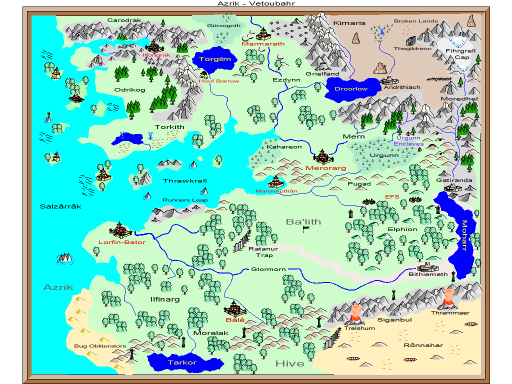
| Category | Wars | |||||||
| Period | 1697 - 1723 | |||||||
| Theater | Azrik, Maleddanar, Ma'Ohari | |||||||
| Belligerents |
| |||||||
| Maps |
|
When the Coeus Civil War (1694 - 1697) ended, Ba'lith's military tore down the churches of the now dead god Coeus. In their place rose grand edifices to the nation's new diabolical religion, the Church of Asmodeus.
With veterans of two consecutive wars, Ba'lith's emperor turned his armies north. He was carrying out the next phase of a plan conceived by Asmodeus. The sword and guile to carry out this phase was Emperor Raxcvillibus, a foreigner, a legendary general of the empire, a hell knight schooled in the diabolical ways, and with a military near-fanatical to him.
In the last two years of the Coeus Civil War, Meshin, a Ba'lith intelligence operative, began collecting information and looking for allies. One operation learned of a bone of contention between Ilfongrak and the Underdark empire Taklumlode. This feud centered on the rich iron deposits of Zirâg-Tharam. Rax and his general staff used this information to formulate a plan for getting an ally.
In 1697, the conflict between the minotaurs of the north and those of the south, along with their allies, came to be known as the Brothers Enmity War.
The goal of Raxcvillibus, Ba'lith's emperor, was the same as others that had previously sat on the Broken Horn Throne, the unification of Azrik. The Torgilm Confederacy (1475 - 1719), the minotaurs and the others of northern Azrik had no interest in being part of the south's warmongering state.
The Minotaur Trade Federation, those with the purse strings, were eager for another war. They knew a long conflict would break the empire's finances, yet if allies could be had they would come out ahead. The MTF took the risk of backing the third in a series of wars with the goal of getting access to the north's unique Carodrak Glass and the great iron veins of Zirâg-Tharam.
Two years into the conflict, feeling the pinch of the Azrik Blockade (1693 - 1729), Ba'lith sought out an ally, someone to help defray costs. Taklumlode joined the war on the side of Ba'lith, bankrolling a conflict that would hopefully gain them a city and a greater share of Zirâg-Tharam.
Fall of Ilfongrak
The battles of this war occurred on the surface and beneath. On the surface, Ilfongrak's mountain defenses provided early warnings of the belligerent's movements. They took the defensive in defiles and across a very rugged landscape. While they battled the armies of Ba'lith in the Carodraks, their enemy's ally Taklumlode smashed into the labyrinth defenses beneath Ilfongrak with hammer golems, herds of gorgons, and other dangerous creatures. On the surface, a Maug mercenary army led the attack against the city's walls. These heavily armored creatures, with their ability to "pulverize" objects, were instrumental in taking the city. They suffered badly in these engagements, taking the brunt of the defenders artillery and magic. General Shali-Vor, a death knight of the Lix Tetrax, laughed at the destruction, his words insulting to his own minotaurs, "listen to your dying foes, they sound like a herd of cattle going to the slaughter". The goal of the war for the south's soldiers was unification, not depopulation. When word of this got back to their emperor, and leader of the Lix Tetrax, Shal-Vor was never heard from again. It is said he was taken out of service, put on ice, which meant placed in a temporal stasis tank, until things settled down.
At night, the enemy leader let out his pack of hungry ghouls, the Bloated Sacs. They dug tunnels, took out enemy wounded, and looked for weaknesses in the enemy's line. After the fall of the city, packs of ghouls trailed the refugees, picking off stragglers. At the gaping maw of Toth Coeus, rather than being eaten by ghouls, dozens jumped to their doom.
- from the book A Refugee's Tale - "Food for Ghouls"
In 1719, Ilfongrak, heart of the Torgilm Confederacy (1475 - 1719), was taken by the armies of Ba'lith. After its fall, the surrounding highlands turned into a guerrilla war lasting another two decades.
Capture of Hlothrabatta
After helping Ba'lith take key places around Ilfongrak, Taklumlode called on the mutual defense pact obligations of Raxcvillibus. Lawfully bound, Rax sent the Starless Army into the deeps. They joined up with the allied armies of King Taklumlode XII, ruler of Taklumlode. Like on the surface, brutal battles spread in the dark, with the city-state Hlothrabatta the bullseye. In the last month of 1723, Hlothrabatta became a holding of the Taklumlode Empire. The Brothers Enmity War was at an end.
During this conflict, a number of Gimrune engineers and scientists of the Torgilm Confederacy fled the region. Yet surprisingly, nearly an equal number stayed put, becoming citizens of the Ba'lith Empire. They were rewarded greatly for their help in the years to come. Ba'lith had long desired crafters with a deep understanding of how to make and maintain sonic weaponry, what the Auhtai called Päiki-Synhö. They also acquired engineers and workers experienced in the building of skyships.
Serving on the side of Ba'lith were thousands of mercenaries from the Bloodtusk Regime. In a deal with Raxcvillibus, the kingdom's undead master - Admiral Bloodtusk, old friends from the early years of the Black Tide, agreed to make no claim to territory, but was free to take all the booty his mercenaries could carry. It is written these Skull Brigadiers, were behind some of the war's worst atrocities - with Maleraunts having a penchant for sending prisoners out the mouth of cannons, or hurled into canyons by way of catapults.
Related Information
Notable Battles
- Siege of Ilfongrak
